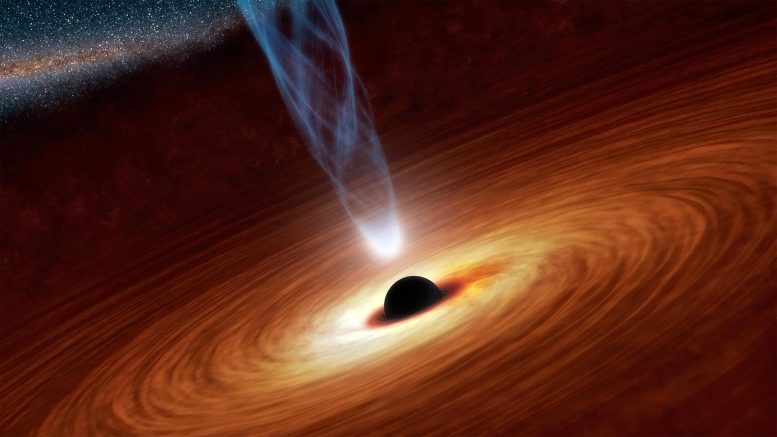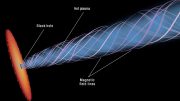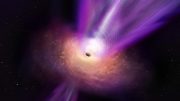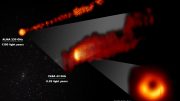
In a groundbreaking study published in Nature Astronomy, a team of researchers led by Eileen Meyer at the University of Maryland, Baltimore County, has challenged the prevailing theories about x-ray emissions from black hole jets. Artist’s concept illustration of a supermassive black hole emitting an x-ray jet. Credit: NASA/JPL-Caltech
Contradicting long-standing theories, a recent study has found that x-ray emissions from black hole jets vary over short periods, and occur throughout the jets rather than solely at their origin. The research, based on data from the Chandra X-ray Observatory, necessitates a reassessment of how particle acceleration works in these jets and potentially the wider universe.
Researchers discovered only relatively recently that black hole jets emit x-rays, and how the jets accelerate particles to this high-energy state is still a mystery. Surprising new findings in Nature Astronomy appear to rule out one leading theory, opening the door to reimagining how particle acceleration works in the jets—and possibly also elsewhere in the universe.
One leading model of how jets generate x-rays expects the jets’ x-ray emissions to remain stable over long time scales (millions of years). However, the new paper found that the x-ray emissions of a statistically significant number of jets varied over just a few years.
“One of the reasons we’re excited about the variability is that there are two main models for how x-rays are produced in these jets, and they’re completely different,” explains lead author Eileen Meyer, an astronomer at University of Maryland, Baltimore County. “One model invokes very low-energy electrons and one has very high-energy electrons. And one of those models is completely incompatible with any kind of variability.”
For the study, the authors analyzed archival data from the Chandra X-ray Observatory, the highest-resolution x-ray observatory available. The research team looked at nearly all of the black hole jets for which Chandra had multiple observations, which amounted to 155 unique regions within 53 jets.
Discovering relatively frequent variability on such short time scales “is revolutionary in the context of these jets, because that was not expected at all,” Meyer says.

Eileen Meyer is the lead author on a new surprising study in Nature Astronomy. The paper appears to rule out a leading theory for how black hole jets form x-rays. Black hole jets are known to emit x-rays, but how they accelerate particles to this high-energy state is still a mystery. One model of how jets generate x-rays expects the jets’ x-ray emissions to remain stable over long time scales. However, the new paper found that the x-ray emissions of a statistically significant number of jets varied over just a few years. The findings open the door to reimagining how particle acceleration works. “Hopefully this will be a real call to the theorists,” Meyer says, “to basically take a look at this result and come up with jet models that are consistent with what we’re finding.” Credit: Marlayna Demond/UMBC
Rethinking particle acceleration
In addition to assuming stability in x-ray emissions over time, the simplest theory for how jets generate x-rays assumes particle acceleration occurs at the center of the galaxy in the black hole “engine” that drives the jet. However, the new study found rapid changes in x-ray emissions all along the length of the jets. That suggests particle acceleration is occurring all along the jet, at vast distances from the jet’s origin at the black hole.
“There are theories out there for how this could work, but a lot of what we’ve been working with is now clearly incompatible with our observations,” Meyer says.
Interestingly, the results also hinted that jets closer to Earth had more variability than those much farther away. The latter are so far away, that by the time the light coming from them reaches the telescope, it is like looking back in time. It makes sense to Meyer that older jets would have less variability. Earlier in the universe’s history, the universe was smaller and ambient radiation was greater, which researchers believe could lead to greater stability of x-rays in the jets.
Critical collaboration
Despite Chandra’s outstanding imaging resolution, the data set posed significant challenges. Chandra observed some of the pockets of variability with only a handful of x-ray photons. And the variability in x-ray production in a given jet was typically tens of percent or so. To avoid unintentionally counting randomness as real variability, Meyer collaborated with statisticians at the University of Toronto and the Imperial College of London.
“Pulling this result out of the data was almost like a miracle, because the observations were not designed to detect it,” Meyer says. The team’s analysis suggests that between 30 and 100 percent of the jets in the study showed variability over short time scales. “While we would like better constraints,” she says, “the variability is notably not zero.”
The new findings poke significant holes in one of the major theories for x-ray production in black hole jets, and Meyer hopes the paper spurs future work. “Hopefully this will be a real call to the theorists,” she says, “to basically take a look at this result and come up with jet models that are consistent with what we’re finding.”
Reference: “Variability of extragalactic X-ray jets on kiloparsec scales” by Eileen T. Meyer, Aamil Shaik, Yanbo Tang, Nancy Reid, Karthik Reddy, Peter Breiding, Markos Georganopoulos, Marco Chiaberge, Eric Perlman, Devon Clautice, William Sparks, Nat DeNigris and Max Trevor, 29 May 2023, Nature Astronomy.
DOI: 10.1038/s41550-023-01983-1









The particles could be harvesting kinetic energy from the reconnections of longitudinal magnetic fields within the jets
Have you considered the “Klystron Effect” due to the intense gravity? Something like this happening: https://adsabs.harvard.edu/full/1978Ap%26SS..53..377R
The phenomena of emission of electromagnetic radiation like x-ray from accretion disk surrounding the supermassive black hole is due to rotation of galaxy.
Rotation of galaxy is given by star dynamics.
Thus,rotation of a galaxy increases with increase of distance in time scale;a higher value of rotation is obtained as calculated from the star dynamics.This law gives strength of x-ray emission from a jet of galaxý’s accretion disk surrounding supermassive black hole with distance in time axis.
Likely,variability of x-ray emission from jet of a galaxy in time scale can be explained.
“There are theories out there for how this could work”
She’s not using the ridiculously special definition of “theory” favored by Einstein’s political fundamentalists for bothering normal people.